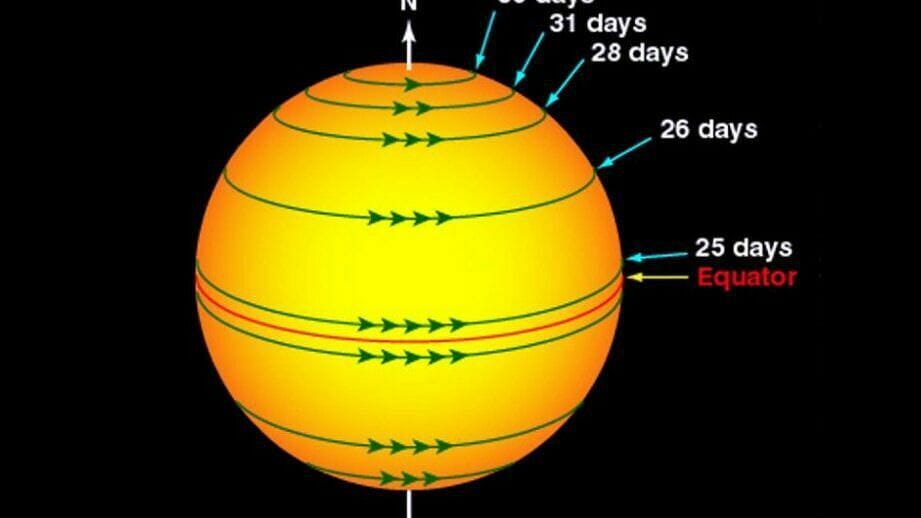What is the object around which the Sun orbits? It is widely known that our star is situated in the Milky Way galaxy, which has a diameter of approximately 30,000 parsecs. A parsec is a unit of measurement in astronomy that is equivalent to 3.26 light-years.
Within the central region of the Milky Way lies a relatively small Galactic Center with a radius of around 1000 parsecs. This area is still actively involved in the formation of stars and houses the nucleus that gave rise to our solar system.
The Sun is positioned closer to the edges of the galaxy, around 26 thousand light years away from the Galactic Center. Alongside all the other stars that form the Milky Way, the Sun orbits this central point. Its speed typically ranges from 220 to 240 kilometers per second.
It takes an average of 200 million years for one complete revolution around the galaxy’s central region. Throughout its entire lifespan, our planet has journeyed around the Galactic core approximately 30 times, accompanied by the Sun.
Time of the Year
The change of seasons occurs as a result of the Earth’s orbit around the Sun. The tilt of the Earth’s axis in relation to its orbit is the main factor contributing to the seasonal variations. As the Earth travels along its elliptical orbit, it is closest to the Sun in January (perihelion) and farthest in July (aphelion). The change in seasons is primarily caused by this tilt, which causes one hemisphere to tilt towards the Sun while the other tilts away, resulting in varying amounts of sunlight. During summer, the Sun reaches its highest point on the ecliptic, resulting in longer days. Conversely, in winter, the Sun appears lower on the horizon, and its rays hit the Earth at an angle. This leads to shorter days.
At different times of the year, various regions of the globe experience exposure to the sun’s rays. During the solstice, the rays are perpendicular to the tropics.
The Axis of the Earth
Our planet is a sphere that rotates on an imaginary axis, similar to a spinning top. If the base of the top is tilted in an unwound state, it will remain balanced. However, if the rotation slows down, the top will eventually fall.
The Earth is not stationary. It is influenced by the gravitational forces of the Sun, Moon, and other celestial bodies in our solar system and beyond. Despite this, it maintains a constant position in space. The initial rotational speed it acquired during its formation is sufficient to maintain a state of equilibrium.
The Earth’s axis does not run perpendicular to the planet’s orbit. It is inclined at an angle of 66°33′. The Earth’s rotation around its axis and the Sun enables the occurrence of seasonal changes. Without this stable orientation, the planet would “tumble” aimlessly in space, making it impossible for environmental conditions and life processes on its surface to remain constant.

What causes the Sun to orbit the galaxy?
The exact reason for the Sun’s movement, just like the Earth’s rotation, is still uncertain. According to one theory, there is a presence of dark matter (a supermassive black hole) in the Galactic center, which influences the rotation and speed of the stars. Surrounding this black hole is another hole with lesser mass.
Together, these two objects exert gravitational forces on the stars in the galaxy, causing them to follow different paths. Other scientists believe that the movement is a result of gravitational forces emanating from the core of the Milky Way.
Just like any other object, the Sun follows a straight path due to inertia. However, it also experiences the gravitational pull of the Galactic center, causing it to orbit in a circular motion.
The International Date Line
The Earth rotates on its axis from west to east. However, the navigators led by Magellan went against this direction. They went around the planet from east to west, resulting in one less sunrise than what they had experienced in Europe during their journey. To avoid such confusion every time someone decides to travel around the world, an International Date Line was established.
This line runs mostly along the 180º meridian and serves as the boundary where the time of day remains the same, but the calendar date changes.
Unlike the prime meridian, the international date line rarely crosses over land. Because of this, in the majority of situations, there is no need to add or subtract a day when traveling around the globe. As previously stated, the majority of the line aligns with the 180º meridian, linking the two poles and only touching land in Antarctica.
Regulation
Modifications in dates should be implemented while crossing the demarcation line. In the event that the vessel proceeds from the eastern region to the western region, the crew is required to increment the numerical value of the calendar by one. Conversely, if the movement occurs in the opposite direction, the number is decremented. In the area where the temporal boundary veers around the Oceania islands, the crew is permitted to alter the date solely after crossing the 180º meridian, provided that the ship does not enter any of the ports, which means that there is no necessity to synchronize with the local time.
The date change line is essentially a conventional boundary that is not based on any physical regularities. It was established for the convenience of international communication. Crossing this line is similar to changing clocks for summer or winter time. These actions help individuals correlate their movement or activity with cosmic processes, but they are not directly derived from them.
This page’s current version has not been verified by experienced users and may vary greatly from the version verified on June 12, 2021; 3 edits are needed for verification.
The Carrington rotation system is a method of comparing the positions of patterns on the Sun’s surface at different points in time, allowing us to track the development of sunspot or flare groups.
Due to variations in the Sun’s rotation parameters based on latitude, layer depth, and time, these comparison systems are only approximate. In the case of the Carrington rotation model, it is assumed that the Sun’s rotation period is 27.2753 days. Each revolution of the Sun in this model is assigned a unique number, starting from November 9, 1853. (A similar scheme, known as the Bartels number [4], uses a rotation period of 27 days and starts counting from February 8, 1832).
The angular distance from the central meridian to a detail on the Sun’s surface is known as the heliographic longitude. This line connects the Sun to the Earth. The Carrington longitude, on the other hand, is the angular distance relative to a fixed point determined by Carrington.
In the 1850s, Richard Carrington used sunspot data from low latitudes to calculate the rotation rate of the Sun. He found that the Sun’s sideric rotation period was approximately 25.38 days. Sideric rotation is measured relative to distant stars. However, because the Earth orbits around the Sun, an observer on Earth would measure the Sun’s rotation period to be approximately 27.2753 days.
An illustration can be created where the spots’ longitude is represented on the x-axis and the time is represented on the y-axis. The longitude is determined by the moment the spots cross the central meridian and follows the Carrington rotation model. By marking the position of sunspots on this illustration after each rotation, it becomes evident that the majority of new spots are consistently situated below the spots from previous rotations. However, over extended periods, slight adjustments to the right or left may occur.
Using sunspots as a means of determining rotational speed
The constants in the rotation model were determined by measuring the movement of different parts of the Sun’s surface. The most well-known of these details are sunspots. Although sunspots have been observed for centuries, it wasn’t until the invention of the telescope that it was discovered that they rotate with the Sun, allowing us to determine the Sun’s rotation period. The English scientist Thomas Harriot is believed to be the first person to observe sunspots through a telescope, as evidenced by sketches in a notebook dating back to December 8, 1610. The findings of Johannes Fabricius, who systematically observed sunspots for several months, were published in June 1611 in a work titled “De Maculis in Sole Observatis, et Apparente earum cum Sole Conversione Narratio” (“A Description of the Spots Observed on the Sun and their Apparent Rotation with the Sun”). This work can be considered as the earliest observational proof of the Sun’s rotation. Christopher Scheiner, in his book “Rosa Ursine sive solis,” published in 1630, was the first to measure the Sun’s rotation rate at the equator and noticed that the rotation at higher latitudes is slower compared to lower latitudes. Therefore, Scheiner can be credited as the discoverer of the Sun’s differential rotation.
Every measurement provides a slightly different outcome compared to the previous one, leading to a standard error (indicated as +/-). S. John (1918) was likely the first to gather published estimations of the Sun’s rotation rate and concluded that explaining the discrepancies in results solely by observer errors and local solar perturbations is challenging; the differences probably stem from variations in the rotation rate. Hubrecht (1915) noted that the two hemispheres of the Sun rotate somewhat differently. Analysis of magnetographic data revealed a synodic period of 26.24 days at the equator and approximately 38 days at the poles. [5]
Rotation of the Sun’s Interior
Prior to the advent of helioseismology, the field of studying solar oscillations, our understanding of the Sun’s internal rotation was very limited. It was previously believed that the differential rotation observed on the Sun’s surface extended throughout its interior. [6] However, thanks to helioseismology data, we now know that the Sun’s rotation does not follow this pattern. Instead, a rotation profile has been determined, revealing that the Sun rotates slower at its poles and faster at the equator. This rotation mechanism also persists within the convective zone. In the tachocline region, there is an abrupt transition to solid-state rotation within the radiative transfer region. [7]
Notes
- ↑Zell, HollySolar Rotation Varies by Latitude(unpublished) . NASA (March 2, 2015). Access date: February 14, 2019.Archived April 1, 2019.
- ↑Beck, J. A comparison of measurements of differential rotation (in English). // Solar Physics(English) ( Russian . – 2000. – Vol. 191 . – P. 47-70 . – doi:10.1023/A:1005226402796. – Bibcode: 2000SoPh..191. 47B .
- ↑Snodgrass, H.; Ulrich, R. Rotation of Doppler features in the photosphere of the sun (in English) // The Astrophysical Journal : journal. — IOP Publishing, 1990. — Vol. 351 . — P. 309—316 . — doi:10.1086/168467. — Bibcode: 1990ApJ. 351..309S .
- ↑ Bartels, J. (1934), Twenty-Seven Day Recurrences in Terrestrial-Magnetic and Solar Activity, 1923-1933, Terrestrial Magnetism and Atmospheric Electricity Vol. 39 (3): 201–202a , DOI 10.1029/TE039i003p00201
- ↑ 5. Astronomy and Astrophysics, vol. 233, no. 1, July 1990, p. 220-228. Archived copy from April 12, 2019 on Wayback Machine
- ↑Glatzmaier, G. A.Numerical simulations of stellar convective dynamos III. At the base of the convection zone(English) // Solar Physics(English) (Russian: journal. — 1985. — Vol. 125 . — P. 1—12 . — doi:10.1080/03091928508219267. — Bibcode: 1985GApFD..31..137G . Archived January 26, 2020.
- ↑Christensen-Dalsgaard J.(English) ( Russian. ; Thompson, M.J.. The Solar Tachocline:Observational results and issues concerning the tachocline (English). – Cambridge University Press, 2007. – P. 53-86.
- ↑ The solution to the puzzle of the Sun’s differential rotation – In-Space(unpublished). . Date of access: February 24, 2022.Archived February 24, 2022.
- ↑Japanese supercomputer unravels the enigma of the Sun’s rotation – Nachedeu(unpublished) . Date of access: February 24, 2022.Archived February 24, 2022.
- ↑The answer to the mystery of the Sun’s differential rotation solved.(unpublished) . Date of access: February 24, 2022.Archived February 24, 2022.
Works of Literature
- Cox, Arthur N., Editor. “Allen’s Astrophysical Quantities”, Fourth Edition, Springer, 1999.
- Javaraiah, J., 2003. Long-Term Variations in the Differential Rotation of the Sun. Solar Physics, Volume 212, Issue 1, Pages 23-49.
- St. John, C., 1918. The Current State of the Issue of Solar Rotation, Publications of the Astronomical Society of the Pacific, Volume 30, Number 178, Pages 318-325.
Sources
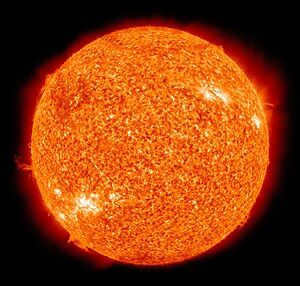

- The Sun is a part of the solar system
- Stars evolve over time
- The Sun rotates
- The Sun has a dynamo
- Geomagnetic storms can occur
- The Sun appears darker towards the edge
Our star is approximately 5 billion years old and will continue to emit light for at least that duration, but compared to numerous distant stars, it is relatively young. For instance, the star HE 1523, which was discovered a few years ago, is already 13.2 billion years old.

Does the Sun classify as a planet or a star? Stars and planets have distinct characteristics, including size, mass, chemical composition, temperature, brightness, and more. Based on all of these factors, our celestial body undeniably falls into the category of stars and specifically belongs to the group of yellow stars.
Life on our planet exists thanks to the Sun, which undergoes nuclear reactions and releases a tremendous amount of energy. However, the Sun is not just an ordinary celestial body we see in the night sky. It has an incredibly high temperature of approximately 15 million degrees and consists of luminous gases. The Sun serves as the center of our solar system, around which Earth and other planets revolve. The size of our star is beyond comprehension, but one can attempt to imagine a million and a half Earth-sized planets fitting inside it. Despite its immense size, the Sun is located at a distance of 150 million kilometers from Earth. The Sun played a crucial role in shaping the structure of our solar system.
Scientific evidence has shown that light travels at a speed of 300,000 kilometers per second. The distance between the Earth and the Sun is approximately 150 million kilometers, which means that light takes about 8.3 minutes to travel this distance. However, when it comes to more distant stars like Alpha Centauri, it takes light about 4.43 years to reach us.
Protective Barrier of the Earth
Unfortunately, direct sunlight can be extremely harmful, but luckily the Earth has a natural defense mechanism in place that shields us from the damaging rays. This protective barrier is none other than our atmosphere, which acts as a gas shell. It is designed to selectively block out the harmful rays while allowing the beneficial ones to pass through.
What causes the rising and setting of the sun?
In ancient times, it was widely believed that the Earth was the center of the universe and that the sun revolved around it. When we observe the sky, we can see that the sun appears to rise in the east and set in the west, creating a motion across the sky. However, these ancient beliefs have been proven incorrect. In reality, our planet orbits the Sun and rotates on its axis, giving the illusion that the sun is moving.
©2013 – 2023 “KidWelcome” – A valuable source of entertainment and educational resources for children
Copying and distributing information is only allowed with a proper attribution.
Contact Us
Our planet is in constant movement. Alongside the Sun, it traverses through space, encircling the center of the Galaxy. And this center, in turn, traverses through the vast Universe. However, the most crucial motion for all living beings is the Earth’s rotation around the Sun and its own axis. Without this movement, the conditions on our planet would be unsuitable for supporting life.
Solar System
Scientists estimate that Earth, as one of the planets in the solar system, formed over 4.5 billion years ago. Throughout this immense timespan, the distance between Earth and the Sun has remained relatively constant. The speed of the planet and the gravitational force exerted by the Sun have created a delicate balance that maintains Earth’s orbit. While not a perfect circle, this orbit is stable. If the Sun’s gravitational force were stronger or if Earth’s speed significantly decreased, the planet would be drawn into the Sun. Conversely, if Earth’s speed increased too much, it would eventually escape the solar system, no longer a part of this celestial arrangement.
The Earth’s distance from the Sun is crucial for maintaining the optimal temperature on its surface. The atmosphere also plays a vital role in this process. The changing seasons, caused by the Earth’s rotation around the Sun, have shaped the adaptability of nature. However, if our planet were positioned farther away, the temperature would plummet, resulting in negative values. Conversely, if it were closer, the excessive heat would cause all the water to evaporate, reaching the boiling point of the thermometer.

An orbit is the path that a planet takes around a star. Unlike a perfect circle, it is elliptical in shape, with a maximum difference of 5 million kilometers. The point on the orbit that is closest to the star is called the perihelion, and for Earth, it occurs in January at a distance of 147 km from the Sun. In July, the planet is at its farthest point from the star, known as the aphelion, which is 152 million kilometers away.
The Earth’s rotation around its axis and the Sun results in changes in daily and yearly patterns, respectively.
For humans, it is impossible to perceive the movement of the planet around the center of the system due to the Earth’s immense mass. However, our journey through space amounts to approximately 30 kilometers per second. While this may seem unimaginable, it is the result of careful calculations. On average, scientists estimate that the Earth is situated approximately 150 million kilometers away from the Sun. Over the course of 365 days, our planet completes one full revolution around the Sun, resulting in a total distance traveled of nearly a billion kilometers.
To be more precise, the exact distance covered by our planet in a year as it orbits the Sun is approximately 942 million kilometers. We are accompanying the Sun in its elliptical orbit through space, moving at a speed of 107,000 kilometers per hour. The direction of this movement is counterclockwise, from west to east.
The planet does not complete a full revolution in exactly 365 days, contrary to popular belief. It actually takes about six additional hours. However, for the sake of convenience, these extra hours are accounted for every 4 years. As a result, an extra day is added to the month of February. This type of year is known as a leap year.
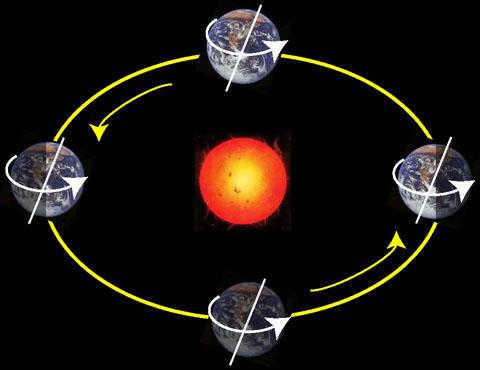
The Earth’s rotation speed around the Sun is not consistent. It experiences variations from the mean value due to its elliptical orbit. The disparity between the values is most noticeable at the points of perihelion and aphelion, amounting to 1 km/sec. These fluctuations go unnoticed as we and all the objects in our surroundings move within the same coordinate system.
The Earth’s orbit around the Sun and the tilt of the planet’s axis enable the occurrence of different seasons. This phenomenon is less noticeable at the equator, but becomes more apparent as one gets closer to the poles. The Sun’s energy heats the northern and southern hemispheres of the planet unevenly.
As the Earth revolves around the Sun, it passes through four specific points in its orbit. During the semiannual cycle, these points determine the distance between the Earth and the Sun (in December and June – solstice days). Consequently, areas where the Earth’s surface is heated more experience higher temperatures, and this period is known as summer. In the other hemisphere, it is noticeably colder during this time, which is referred to as winter.
Following three months of this cyclical motion, which occurs twice a year, the planetary axis aligns in such a manner that both hemispheres experience similar heating conditions. During this period, known as the equinoxes, which occur in March and September, the temperature regimes are nearly identical. Following this, depending on the hemisphere, autumn or spring commences.
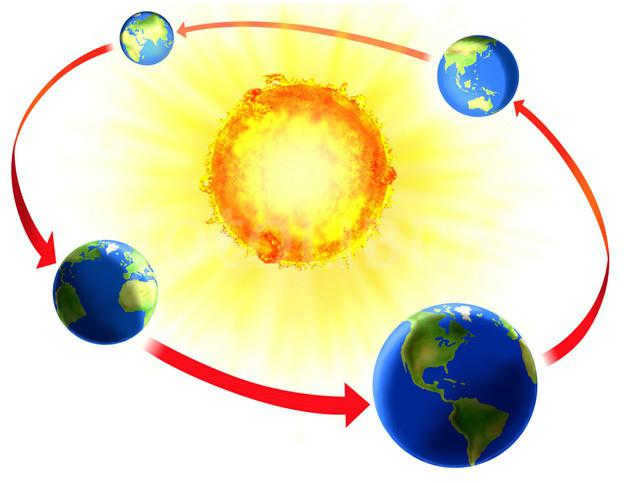
Rotation of the Earth
Our planet is a spinning sphere. It rotates around an imaginary axis, following the principle of a spinning top. If you were to place the base of a top on a flat surface, it would remain balanced. However, if the rotational speed decreases, the top will eventually fall.
The Earth has no solid foundation. It is influenced by the gravitational forces of the Sun, Moon, and other celestial bodies in our solar system and beyond. Despite this, it maintains a steady position in space. The initial rotational velocity it acquired during its formation is sufficient to maintain a state of relative equilibrium.
The axis of the Earth does not run straight through the planet’s orbit. Instead, it is inclined at an angle of 66°33′. This tilt, combined with the Earth’s rotation around its axis and its orbit around the Sun, is what allows for the changing of seasons. Without this tilt, the Earth would “roll” aimlessly through space, leading to unpredictable and extreme environmental conditions that would make life as we know it impossible.
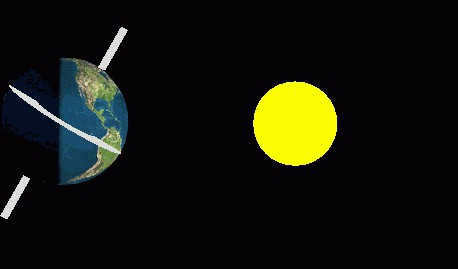
Axial rotation of the Earth
The Earth undergoes one complete revolution around the Sun in a year, resulting in the change of seasons. Additionally, the Earth experiences a cycle of day and night within a 24-hour period. When observed from space, the Earth’s North Pole rotates counterclockwise, completing a full rotation in approximately 24 hours, which is commonly referred to as a day.
The speed of the Earth’s rotation directly impacts the transition between day and night. The planet rotates at a rate of about 15 degrees per hour. However, due to its spherical shape, the speed of rotation varies at different points on its surface. At the equator, the linear speed reaches 1669 km/hour or 464 m/sec. As one moves closer to the poles, the linear speed decreases. For example, at the thirtieth latitude, the linear speed reduces to 1445 km/hour (400 m/sec).
The compression of the planet’s shape due to its axial rotation causes moving objects, including air and water currents, to deviate from their original direction (known as the Coriolis force). Additionally, tides are an important result of this rotational motion.
Alteration of Day and Night
The phenomenon of day and night occurs when a spherical object, such as our planet, is only partially illuminated by a single light source. This means that at any given moment, one part of the planet will experience daylight, while the other part will be in darkness, hidden from the Sun. The rotation of the planet’s axis allows for the periodic change of these periods.
In addition to the alternation of light and darkness, the heating conditions of the planet’s surface by the energy of the light source also vary. This cyclical process is of utmost importance, as it allows for a relatively rapid change in both light and thermal regimes. Within a 24-hour period, the surface of the planet neither becomes excessively heated nor cools down below the optimal temperature.
The constant speed at which the Earth rotates around the Sun and its axis is vital for the existence of animal life. If the orbit were not constant, the planet would not remain in the optimal temperature zone. Similarly, if the Earth did not rotate on its axis, day and night would each last for half of the year. These conditions would not be favorable for the emergence and survival of life.

Irregular revolution
Throughout its history, humanity has grown accustomed to the perpetual cycle of day and night. This cycle has served as a time marker and a representation of the consistency of life’s rhythms. The duration of Earth’s revolution around the Sun is influenced, to some extent, by the elliptical shape of its orbit and the presence of other planets in the solar system.
Research is currently being conducted on the effects of the Earth’s orbit around the Sun and its rotation on its axis. These studies hold significant practical and scientific value, as they not only contribute to the accurate determination of celestial coordinates, but also help identify patterns that can impact various human and natural processes, including those in hydrometeorology and other fields.
Despite its spherical shape, the Earth is not a perfect sphere. Its rotation causes a slight flattening at the poles, resulting in a figure commonly referred to as a spheroid or geoid – resembling the shape of the Earth.
The Earth is truly immense, making it difficult to comprehend its size. Its primary parameters are as follows:
- Diameter – 12,570 km
- Equatorial circumference – 40,076 km
- Meridional circumference – 40,008 km
- Total surface area – 510 million km2
- The radius of the poles is 6357 km.
- The radius of the equator is 6378 km.
The Earth rotates simultaneously around the sun and its own axis.
The Earth revolves around a tilted axis, moving from west to east. Daytime occurs on one half of the globe, where it is illuminated by the sun, while the other half is in darkness, creating nighttime. The rotation of the Earth causes the alternation of day and night. It takes the Earth 24 hours to complete one revolution around its axis, which is known as a day.
As a result of the Earth’s rotation, moving streams such as rivers and winds are deflected to the right in the northern hemisphere and to the left in the southern hemisphere.
Rotation of the Earth around the Sun
The Earth revolves around the Sun in a circular orbit, completing a full revolution in one year. The Earth’s axis is tilted at an angle of 66.5° to the orbit, and this tilt remains constant throughout the rotation. This rotation has a significant impact on the changing of seasons.
Let’s examine the points of greatest and least distance between the Earth and the Sun during its rotation.
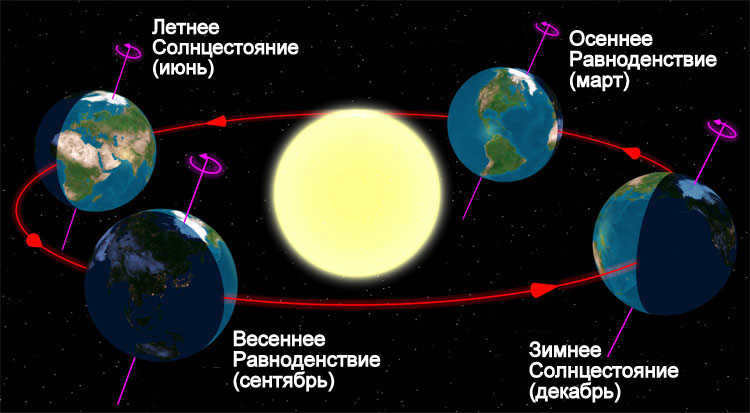
- On December 22nd, the winter solstice occurs. During this time, the sun is closest to the zenith at the southern tropic, resulting in summer in the southern hemisphere and winter in the northern hemisphere. Nights are short in the southern hemisphere, and at the southern polar circle, the day lasts for 24 hours without any night. On the other hand, in the northern hemisphere, the opposite occurs, with the night lasting for 24 hours at the northern polar circle.
- June 22nd marks the day of the summer solstice. The northern tropic is closest to the sun during this time, resulting in summer in the northern hemisphere and winter in the southern hemisphere. At the southern polar circle, the night lasts for 24 hours, while at the northern polar circle, there is no night at all.
- March 21, September 23 – are the dates when the spring and fall equinoxes occur. At the equator, which is closest to the sun, the duration of day and night are equal in both hemispheres.
A sunspot located on the equator of the Sun completes a full revolution around the Sun’s axis and returns to its initial position in 24.47 days. This period is known as the sideric orbital period among astronomers, and it differs from the synodic orbital period, which is the time it takes for a sunspot to reappear. However, as you move closer to the poles, the Sun’s rotation rate around its axis decreases, resulting in a 38-day period for the regions near the poles to complete one revolution around the Sun’s axis.
The movement of sunspots across the surface of the Sun allows us to observe the Sun’s rotation around its axis. Unlike a solid body, the Sun exhibits differential rotation, with faster rotation at the equator and slower rotation at the poles. This phenomenon is also observed in gas giants. To measure the Sun’s rate of rotation, astronomers chose an arbitrary position 26° from the equator, where most sunspots are visible. From this point, it takes the Sun 25.38 days to complete one revolution around its axis and return to the same location in space.
Moving in a circular path around the center, the Solar System has an average speed of 828,000 km/h. At this velocity, it would require approximately 230 million years for the Solar System to complete a full revolution around the galaxy. The Milky Way is classified as a spiral galaxy, composed of a central bulge, four primary arms, and numerous shorter arm segments. Our Solar System, including the Sun, is situated near the Orion arm, positioned between the larger Perseus and Sagittarius arms. Spanning a diameter of about 100,000 light years, the Milky Way’s Galactic Center is located 28,000 light years away from the Sun. In more recent times, there has been speculation that the Milky Way is indeed a spiral galaxy with a twist. This suggests that instead of a bulge of gas and stars at the center, there might be a crossover of stars intersecting the central bulge.
If someone asks about the rotation of the Sun around its axis, inquire about which specific part of the Sun they are referring to.
What causes the Sun to rotate around its axis? Is it the movement of its layers, the speed of its poles and equator, the length of its day, or its rotation around the center of the Milky Way?
Determining the rotation of the Sun is a complex task that depends on the specific part of the Sun being discussed. This has been a longstanding puzzle for astronomers. Let’s examine how the Sun’s rotation varies.
The sidereal rotation period of the solar equator is approximately 24.47 days, according to astronomers. It is important to note that this is distinct from the Synodal period, which refers to the time it takes for a sunspot to return to face Earth. As we move closer to the poles, the rate of rotation of the sun’s axis gradually decreases. Consequently, the stellar rotation period can extend up to 38 days for regions near the poles.
By observing the Sun, one can witness its rotation. Sunspots can be seen moving across its surface, indicating the overall rotation of the Sun about its own axis. Extensive research has demonstrated that the Sun does not rotate as a solid body; rather, it exhibits differential rotation. Specifically, the equator of the Sun rotates at a faster pace compared to its poles. This differential rotation phenomenon is also observed in other celestial bodies.
Therefore, scientists initiated the measurement of the rotation axis’s velocity from a random location at 26 degrees on the equator, which approximately corresponds to the area where the majority of sunspots are observed. At this particular point, the rotation at the equator completes a full cycle in 25.38 days (meaning it takes that amount of time to make a complete turn and return to the same spatial position).
Astronomers possess knowledge regarding the differing rotation patterns between the interior and surface of the Sun. Initially, the inner regions, including the core and radiation zones, undergo rotation. Subsequently, the outer layers initiate their rotation, as well.
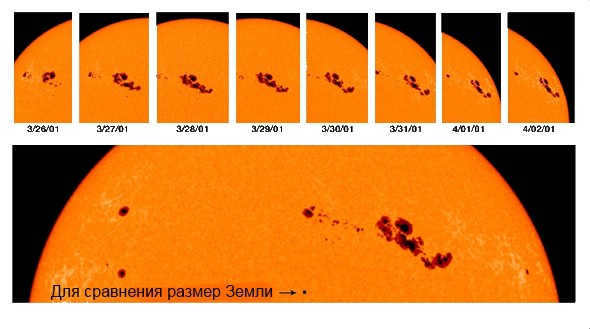
The rotation speed of the solar system is in constant motion. The average speed at which our system rotates is 828,000 kilometers per hour. In such a scenario, it would take our Sun approximately 230 million years to complete one revolution around the Milky Way. The Milky Way is classified as a spiral galaxy, comprising of a central bulge, four arms, and various smaller segments. The Sun is situated close to the Orion arm, positioned between the arms and . Our galaxy spans a distance of one hundred thousand light years, with us being located 28,000 light years away from the center. A relatively recent theory proposes that our galaxy is, in fact, a spiral galaxy. This implies that instead of a bulge of gas and stars in the core of the galaxy, there is a cluster of stars intersecting the central bulge.
The Earth completes one revolution around its axis in 27.275 days (the synodic period of revolution), and one revolution relative to the fixed stars in 25.38 days (the sideric period of revolution).
From the Large Encyclopedic Dictionary, 2000.
For more information on “solar rotation,” refer to other dictionaries:
The Earth’s rotation around its axis occurs in the same direction as its overall rotation (from west to east). The axis of rotation forms an angle of 82°45 with the plane of the Earth’s orbit (ecliptic). One revolution around the Earth takes 27.275 days (the synodic period) … … according to the Encyclopedic Dictionary
The Sun rotates around an axis that is inclined at an angle of 82 degrees 45 minutes to the plane of the Earth’s orbit. It takes 27.275 days for one complete revolution of the Sun relative to the Earth, which is known as the synodal period of revolution. The direction of rotation is the same as that of the Earth, from west to east. This information can be found in the Astronomical Dictionary.
The rotation of the Sun around its axis occurs in the same direction as the rotation of the Earth, from west to east. The axis of rotation is inclined at an angle of 82 degrees 45 minutes to the plane of the Earth’s orbit, also known as the ecliptic. It takes 27.275 days for one revolution of the Sun relative to the Earth, and for one revolution relative to the fixed stars, you can refer to the Natural Science. Encyclopedic Dictionary.
Axial rotation of celestial bodies – the rotation of the Sun was first observed by G. Galileo (1564 1642) through the movement of sunspots (see Sun). The rotation of other stars was initially detected in 1909 by F. Schlesinger (1871 1943) while studying the spectra of eclipsing binary stars. Most … … … Concepts of Modern Natural Science. Dictionary of Basic Terms
ROTATION, rotation, m. no, cf. (book.). Movement around its axis in a circular manner. The Earth undergoes daily rotation. The Earth’s rotation around the sun. Rotation of a gear wheel. Ushakov’s Explanatory Dictionary. D.N. Ushakov. 1935 1940 … Ushakov’s Explanatory Dictionary
This term has various meanings, please refer to Rotation (meaning). The rotation of a sphere around an axis is a circular motion of an object. In a two-dimensional space, an object rotates around a center (or a point) of rotation. In a three-dimensional space, an object … … Wikipedia
Illustration demonstrating the visual effect of a flattened Ahernar star due to its rapid rotation. Stellar rotation refers to the angular motion of a star around its axis. The rate of rotation can be determined by the displacement of lines in its spectrum or by the duration of the motion … … Wikipedia
Illustration demonstrating the visual effect of a flattened Ahernar star due to its rapid rotation. Stellar rotation refers to the angular motion of a star about its axis. The rotation rate can be measured by the shift of lines in its spectrum or by the duration … Wikipedia
One of the movements of the Earth. V. Z. clarifies the transition between day and night, the apparent daily movement of celestial bodies, and various phenomena that occur on the Earth’s surface: the rotation of a swinging weight suspended on a thread (refer to the Foucault pendulum), the… … … The Big Soviet Encyclopedia
WIND ROTATION – a change in wind direction over time, either clockwise (to the right) or counterclockwise (to the left). On warm, cloudless days, the wind shifts so that it blows “from the sun,” meaning in the morning it comes from the east, in the afternoon it comes from the south, and in the evening it comes from the west (refer to the Solar … Dictionary of Winds
Books
- Volzhin A.S. has spent about 40 years working on this scientific work, driven by his personal passion. In it, he presents a fresh perspective on the motion of the Earth. This piece of research is equally as significant as the others mentioned…
- Volzhin A. introduces a new concept of the Earth’s motion in this scientific work, which he has dedicated approximately 40 years to. This endeavor is fueled by his personal passion and is of great importance, comparable to the works mentioned…

